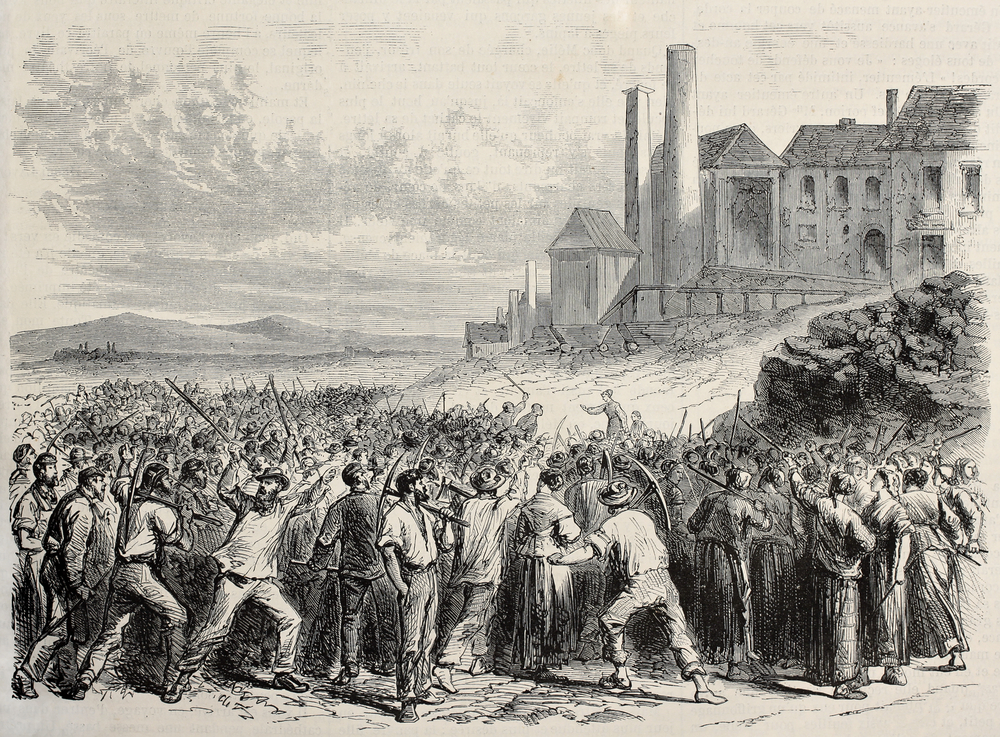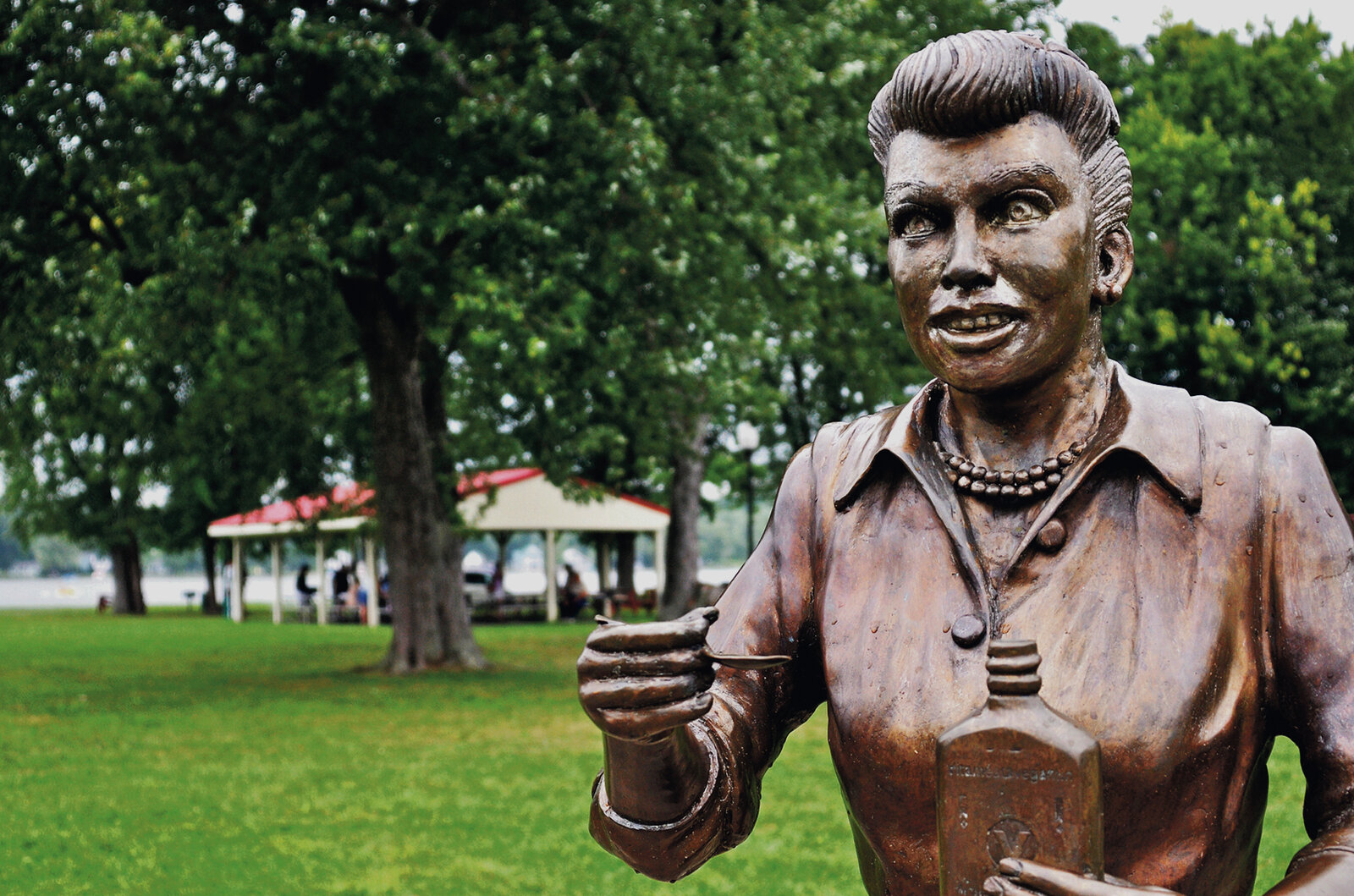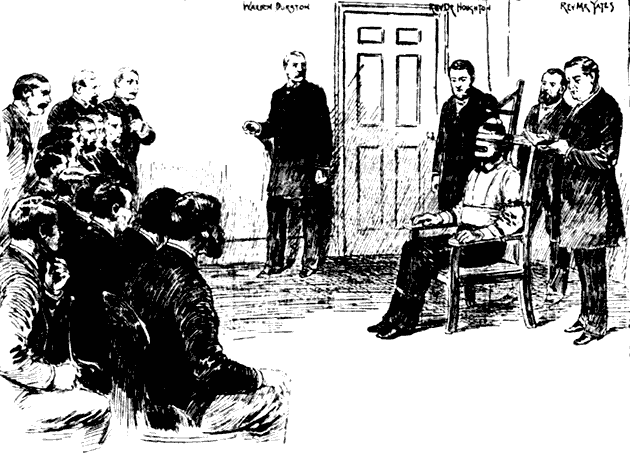![]()
A Mass Hanging of Prairie Women

A Mass Hanging of Prairie Women

THIS DAY IN HISTORY: AUGUST 6TH- BLOODY MONDAY

This Day In History: August 6, 1855
Monday, August 6, 1855 was an election day in Louisville, Kentucky. The political field looked a bit different then, with the two main parties being the Democrats and the Know-Nothings (an offshoot of the Whig Party), but they faced a lot of the same issues that the Democrats and Republicans do today- they just didn’t get along. An election is enough to get anyone’s blood boiling, and back in 1855 a number of issues came to a head, resulting in some of the worst riots in Louisville history.
The Know-Nothings were also called “American Nativists.” It was largely comprised of white protestants whose families had already laid down their roots in the United States. They considered themselves to have old American blood, however old American blood could be at the time. The Democratic Party, on the other hand, attracted a lot of the recent Irish and German immigrants who were mostly Catholic. Thousands of immigrants had settled in Louisville and the Know-Nothings weren’t very happy about it. They thought that the immigrants would “undermine the American way of life.” …
Bill Maher presses Wikileaks’ Assange: ‘Why don’t you hack into Trump’s tax returns?’
THANKS to HBO and Real Time with Bill Maher for making this program available on YouTube.
 While discussing Wikileaks’ release of information concerning the Democratic National Committee, Real Time host Bill Maher took a second to ask the site’s editor-in-chief, Julian Assange, about taking on the other side.
While discussing Wikileaks’ release of information concerning the Democratic National Committee, Real Time host Bill Maher took a second to ask the site’s editor-in-chief, Julian Assange, about taking on the other side.
“Why don’t you hack into Donald Trump’s tax returns?” Maher asked Assange, who was speaking via satellite from the Ecuadorian embassy in London.
“We’re working on it,” Assange replied.
While Maher told Assange he felt he should win a Nobel Prize, the two did spar when Assange said his site’s findings — which spurred the resignation of DNC head Debbie Wasserman Schultz — constituted evidence of “a plot” by Democratic officials against Sen. Bernie Sanders’ campaign. …
Trump campaign teeters on the brink

Like a boxer on the ropes, the Trump campaign has weathered a flurry of body blows over the past few weeks. Is this the beginning of the end, a full three months before election day? Should Donald Trump throw in the towel before the inevitable November knockout?
The latest round of national polls has set off something akin to a mass panic among Republican officeholders and intelligentsia, with some wishing Mr Trump would just quit already and leave them to pick up the pieces.
Here’s why.
Hillary Clinton is up seven percentage points in a CBS survey, nine in CNN and NBC, an eye-popping 15 in a Marist survey that had the race within the margin of error just a few weeks ago. She’s posting sizeable leads in key swing states like Pennsylvania, Michigan, New Hampshire and Florida. She’s even leading in Georgia, a state Republican Mitt Romney carried by 8 percentage points. …
10 People Who Did Great Things While Intoxicated
Say what you want about drugs and alcohol, but they’ve spurred many people to success. For some historical figures, it was an integral part of their process. Others just happened to get wasted and have a good idea. Either way, being intoxicated helped these people make it into the history books.
10. Jules Goux

On May 30, 1913, French racer Jules Goux became the first European to win the Indianapolis 500. The following year, the race organizers instituted a ban on drinking alcohol while driving. That’s because Goux, according to racing legend, drank six bottles of champagne on his way to victory.
The story changed over the years, and the version best remembered says that Goux had a bottle of champagne at each pit stop. However, modern historians believe that figure to be exaggerated. They claim Goux “only” had four or five bottles of champagne or chilled wine which he politely shared with his riding mechanic, Emil Begin.
Either way, Goux definitely drank more than advisable while racing one of the fastest cars of the time. Jules Goux won by 13 minutes and afterward said, “Without the good wine, I would not have won.” …
This Company Has Built a Profile on Every American Adult
Every move you make. Every click you take. Every game you play. Every place you stay. They’ll be watching you.

Forget telephoto lenses and fake mustaches: The most important tools for America’s 35,000 private investigators are database subscription services. For more than a decade, professional snoops have been able to search troves of public and nonpublic records—known addresses, DMV records, photographs of a person’s car—and condense them into comprehensive reports costing as little as $10. Now they can combine that information with the kinds of things marketers know about you, such as which politicians you donate to, what you spend on groceries, and whether it’s weird that you ate in last night, to create a portrait of your life and predict your behavior.
IDI, a year-old company in the so-called data-fusion business, is the first to centralize and weaponize all that information for its customers. The Boca Raton, Fla., company’s database service, idiCORE, combines public records with purchasing, demographic, and behavioral data. Chief Executive Officer Derek Dubner says the system isn’t waiting for requests from clients—it’s already built a profile on every American adult, including young people who wouldn’t be swept up in conventional databases, which only index transactions. “We have data on that 21-year-old who’s living at home with mom and dad,” he says. …
Rejected for credit? Newfangled scores may be to blame
Joseph is 43, owns a house in Huntington Beach and works in the entertainment industry. He’d rather I just use his first name because he’s going to discuss his FICO credit score — it’s very high — and is concerned about identity theft.
At issue is a rejection letter Joseph received recently from Bank of America after he applied for a credit card that came with a bunch of Alaska Airlines miles. The bank’s decision, it said, was based on a variety of factors, including “your total relationship with us, current economic trends and a copy of your credit report or reports.”
It used to be that consumers needed to worry only about their FICO score, which primarily reflects how well you pay your bills. Now there are dozens of new players on the credit-reporting scene, each purporting to up FICO’s game by adding their own secret sauce.
Joseph’s experience shows that even if you think you have a stellar credit file, you may need to think again.
It also highlights, as you’ll see, how various corporate entities drink from the vast watering hole that is Big Data, seeking opportunities to profit from people’s most sensitive personal information. …
10 Ways Ancient Egyptians Influenced Modern Life
As ancient civilizations go, the Egyptians are by far one of the more well known. Their pyramids still stand to this day, and their mummies and sarcophagi pepper our museums, but is there more to them?
Turns out, some aspects of our modern life found their start in Egypt.
10. Mathematics
The Egyptians were remarkable at mathematics. The earliest records of geometry come from Egypt, as their geometry specialists were called “arpedonapti.” The arpedonapti used ropes to calculate the area of lands, eventually passing this knowledge to Greece.
Egyptians also worked out efficient ways of performing multiplication and division. While we have various ways to perform such calculations, Egyptians used a more computation-friendly method that involved doubling numbers, a technique we still use in modern-day computing. The above video goes into detail as to how computers and ancient Egyptians come together. …
The Colorado Company That’s Tackling 36 Million Tons of Food Waste
The United States throws away 36 million tons of food each year, which amounts to 40 percent of the total food generated. However, this massive issue presents a big recycling opportunity. In this short film from the web series The Perennial Plate, we tour A1 Organics in Colorado, which uses a machine called biogas digester to turn that waste into renewable natural gas. …
Let them eat bugs: US startup sees future of sustainable food in creepy crawlies
Grubbly Farms is raising black soldier flies as a substitute for wild-caught fish in food for livestock and farmed seafood

The experiment started inside the laundry room of an apartment in Atlanta, Georgia, where the two college students created a nursery for 700 larvae of black soldier flies they bought on Amazon for $20. Sean Warner and Patrick Pittaluga weren’t raising the writhing bugs as pets. They were raising food for animals.
Warner and Pittaluga, who are cousins and Georgia Tech graduates, eventually moved the larvae farm out of their apartment and founded Grubbly Farms, which is breeding and selling larvae as a more sustainable protein and fat source for for chickens, pigs and farmed seafood. Right now, wild-caught fish is a key ingredient in animal feed.
The little critters, Warner said, can help solve some of the planet’s most vexing environmental challenges.
“I tell all my friends that bugs are the future,” he said. …

THIS DAY IN HISTORY: AUGUST 6TH- HAVING A BALL

This Day In History: August 6, 1911
Lucille Ball, one of the greatest comedic forces in entertainment history and the embodiment of a classic rags-to-riches tale, was born on August 6, 1911, in Jamestown, New York. Her father died of typhoid when she was three, so her mother DeDe found factory work and a new husband, but this didn’t improve their economic situation much.
Lucy was interested in the theater and often took part in school plays. In 1926, her mother enrolled her in the John Murray Anderson/Robert Milton School of Theater and Dance in New York, but compared to star pupil Bette Davis, she was a dismal failure. The school’s proprietor wrote to DeDe advising her that she was wasting her money. Lucy returned to Jamestown and life as an ordinary high school student. …
A New Lucille Ball Statue Replaces ‘Scary’ One In Her Hometown

Despair no more, fans of Lucille Ball.
A new statue of the queen of comedy will be unveiled this weekend in her a hometown in Celoron, N.Y., and unlike the old one, this one actually looks like the Lucy everyone loves.
The new life-size bronze statue was created by noted sculptor Carolyn Palmer who won a national competition (involving more than 65 sculptors) for the honor of crafting a statue that will be unveiled on Aug. 6. It would have been Ball’s 105th birthday.
The new statue was commissioned to replace another sculpture unveiled just seven years ago. Critics complained the original didn’t even resemble Ball and it soon came to be known as “Scary Lucy.” Its creator, artist Dave Poulin, apologized for the work and offered to re-make the sculpture. …
NASA Suspends Future Live TV Feeds from the International Space Station –“Move Follows UFO Cover Up Claims”
NASA has announced that the space agency has suspended future live TV feeds from the International Space Station. UFO theorists will now surely look at NASA’s move as further confirmation after a live NASA video feed by the ISS was cut on July 9th as a blurry round object was seen descending from the upper-right corner on the live feed before the screen went dark as the UFO appeared to stop and a notice followed indicating technical difficulties. The incident was captured on a You Tube video that prompted alien hunters and conspiracy theorist to think that NASA was covering up the sighting.
Some reports theorized the object may be Chinese space station Tiangong-1, which was launched in 2011. NASA has been accused of cutting live feed before as an April video showing a horseshoe-like object supposedly changing direction suspiciously dropped.
NASA spokesman Daniel Huot told the Daily News in an email that the camera’s signal was simply interrupted. The video was part of an experiment researching how ordinary cameras function in the harsh environment of space. Huot said sometimes the cameras lose connection with satellites used to transmit video to the ground, which is what happened in this case.
…
The Drug Commercial That Gets Way Too Real With You
The camera pans to me sanding down a piece of antique furniture. I look handsome and confident, assured in my movements.
“When my doctor told me I had Distressing Ass Syndrome, I had a lot of questions. What was that? Would I be able to keep sanding antique furniture? Would the police finally find me? Would children point and laugh at me on the street, more so than they do now?”
I walk across my workshop and sit down, where I begin sanding two pieces of antique furniture, one with each hand.

What an easy-to-film, appropriately upper-class hobby.
“But after he explained DAS, and why God had so forsaken me, and asked me to settle down and climb off his desk, he told me about Comtransa, a new drug from the makers of Philaxistool. He said that Comtransa can help sufferers of DAS lead normal, healthy lives.”
Now I’m rubbing one piece of antique furniture with another. An attractive woman in her 50s brushes my hair. We both turn to the camera. I go on:
“Now I don’t have to worry about the hate-filled stares, or the odor, or suddenly rising a few feet off the ground. And I don’t need to tell you …”
I turn to smile at the beautiful woman brushing my hair. She smiles back warmly.
“… it’s made me a far more selfish and uncaring lover, as well.”
Myself, the beautiful woman, and another even older and even more attractive woman ride a horse on the beach.

Just the one horse.
…
We just got even weirder results about the ‘alien megastructure’ star
Something strange is definitely going on.

Last year, the world freaked out over the discovery of a star that was dimming and flickering so erratically, it couldn’t be explained by any known natural phenomenon – prompting one scientist to actually go there and suggest it could be evidence of some kind of alien megastructure.
Follow-up studies have revealed no signs of alien behaviour, but NASA’s Kepler Space Telescope has just spent around 1,600 days observing the star, and things have gotten a lot weirder.
“We spent a long time trying to convince ourselves this wasn’t real,” one of the researchers, Ben Montet from Caltetch, told Maddie Stone over at Gizmodo. “We just weren’t able to.”
The results of these latest observations have just gone up on pre-print site arXiv, so other members of the astronomy community can do their best to poke holes in them – which means we can’t read too much into them for now. …
Maya ‘snake dynasty’ tomb uncovered holding body, treasure and hieroglyphs
• Find is ‘one of the largest burial chambers ever discovered in Belize’
• Hieroglyphic panels, skeleton and offerings hidden for 1,300 years

Archaeologists have uncovered what may be the largest royal tomb found in more than a century of work on Maya ruins in Belize, along with a puzzling set of hieroglyphic panels that provide clues to a “snake dynasty” that conquered many of its neighbors some 1,300 years ago.
The tomb was unearthed at the ruins of Xunantunich, a city on the Mopan river in western Belize that served as a ceremonial center in the final centuries of Maya dominance around 600 to 800AD. Archaeologists found the chamber 16ft to 26ft below ground, where it had been hidden under more than a millennium of dirt and debris.
Researchers found the tomb as they excavated a central stairway of a large structure: within were the remains of a male adult, somewhere between 20 and 30 years old, lying supine with his head to the south.
The archaeologist Jaime Awe said preliminary analysis by osteologists found the man was athletic and “quite muscular” at his death, and that more analysis should provide clues about his identity, health and cause of death. …
10 Disasters That Sparked New Safety Regulations
Disasters involving disease, fire, maritime catastrophes, mine explosions, airplane crashes, oil spills, and earthquakes have led to the losses of millions of dollars and hundreds, even millions, of lives. Man-made cataclysms are sometimes preventable. On occasion, they occur because of violations of existing safety laws or regulations. Other times, they are due to carelessness. Natural disasters may not be avoidable, but their ill effects sometimes can be reduced.
Although disasters are horrific, they often expose weaknesses in the safety laws and regulations designed to protect people from the property loss, injury, and death that such events typically cause. Sometimes, disasters also indicate a need for new ordinances. Often, such events motivate officials to take administrative, legislative, and judicial actions that are long overdue.
Here are 10 disasters that sparked new safety laws and regulations.
10. Black Death

In October 1347, a dozen Genoese ships, having sailed through the Black Sea, docked at Messina, Sicily. Most of the sailors aboard were dead. The few who had lived were deathly ill. From their boils, their illness took its name: the “Black Death.” Although authorities ordered the “death ships” to return to sea, the Black Death killed over 20 million people in Europe—one-third of its population—over the next five years.
Italian cities were the first to combat the Black Death with new safety laws and regulations. Venice barred ships suspected of carrying the plague from its ports. The city subjected other ships and their passengers to quarantine for 30 (later 40) days. The dead were interred in isolated graveyards in accordance with regulations specifying procedures for collection, conveyance, and burial. Pistoia restricted “imports, exports, and travel,” and Milan established a “pesthouse” outside the city gates for infected individuals. …
Climate Change Could Release Cold War-Era Radioactive Waste In Greenland
Fuel and radioactive coolant was left at Camp Century, built in 1959 as part of U.S. research into the potential for nuclear missile launch sites in the Arctic

Global warming could release radioactive waste stored in an abandoned Cold War-era U.S. military camp deep under Greenland’s ice caps if a thaw continues to spread in coming decades, scientists said on Friday.
Camp Century was built in northwest Greenland in 1959 as part of U.S. research into the feasibility of nuclear missile launch sites in the Arctic, the University of Zurich said in a statement.
Staff left gallons of fuel and an unknown amount of low-level radioactive coolant there when the base shut down in 1967 on the assumption it would be entombed forever, according to the university.
It is all currently about 35 meters (114.83 ft) down. But the part of the ice sheet covering the camp could start to melt by the end of the century on current trends, the scientists added. …
The Convenience-Store Innovator of Bend, Oregon
In his 19 years of owning a gas station, Kent Couch has rolled out a beer cave, kombucha on tap, and uniformed attendants who greet customers by name.

Although mom-and-pop shops have been around for more than a century, the first predecessor of the convenience store in the U.S. is said to be a multipurpose gas station that opened in 1913 in Pittsburgh. At that time, gas stations started to sell car-repair items and snacks. The Southland Ice Company, usually identified as one of the first “real” convenience stores in the U.S., opened in 1927 in Dallas, Texas, and its main feature was having extended store hours. The Southland Ice Company is, in some sense, still around today: In 1946, the company changed its name to reflect the stores’ hours—7‑Eleven.
It wasn’t until the 1960s that convenience stores became 24-hour operations. Now, the National Association of Convenience Stores counts over 150,000 of them in the U.S. in 2015, doing some $225 billion in annual sales—a large number, but increasingly, convenience stores are facing competition from drug stores and supermarkets with extended hours, dollar stores with extremely low prices, and online retailers that offer home delivery.
Kent Couch runs a gas station and convenience store in Bend, Oregon. Though he’s owned the store for nearly 20 years, Couch continues to experiment with different concepts and ways to modernize the convenience store. I talked to him about how he got into the convenience-store business and his aspirations for his store. The interview that follows has been lightly edited for length and clarity. …

THIS DAY IN HISTORY: AUGUST 6TH- A MORE HUMANE CAPITAL PUNISHMENT?

This Day In History: August 6, 1890
 “I would rather see ten hangings than one such execution as this. In fact I never care to witness such a scene again. It was fearful. No humane man could witness it without the keenest agony.” – Deputy Coroner Jenkins of New York
“I would rather see ten hangings than one such execution as this. In fact I never care to witness such a scene again. It was fearful. No humane man could witness it without the keenest agony.” – Deputy Coroner Jenkins of New York
On August 6, 1890, murderer William Kemmler became the first person to die in the electric chair in what went down as one of the most grisly and inhuman executions in American history.
The fact that Kemmler’s demise was so ghastly is ironic considering the electric chair was introduced in an effort to make the death penalty less distasteful because, after a series of botched hangings in the 1880s, the general public was shying away from the practice. Death by electrocution was intended to make capital punishment more “humane.”
The notion of electrocution as a more merciful method of execution began when a dentist named Dr. Albert Southwick observed an old vagrant die “painlessly” after bumping into the terminals of an electric generator in Buffalo, New York. After experimentally zapping progressively larger animals into oblivion the idea gained traction, and ended up turning into a cat fight between the two financial leaders of the fledgling electrical industry – Thomas Edison and George Westinghouse. …
Video Goodnesses
(and not-so-goodnesses)
(and not-so-goodnesses)
 Sam lifts the lid on the most secretive country on Earth, like the anarchic rebel he is, with a little bit of help from his friend… (it’s not Kim Jong-Un by the way)
Sam lifts the lid on the most secretive country on Earth, like the anarchic rebel he is, with a little bit of help from his friend… (it’s not Kim Jong-Un by the way)